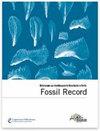A case study of developmental palaeontology in Stereosternum tumidum (Mesosauridae, Parareptilia)
IF 2.1
4区 地球科学
Q1 PALEONTOLOGY
引用次数: 4
Abstract
Abstract. Ontogenetic series of extinct taxa are rare. However, if preserved, fossil embryos and juveniles can provide evidence of developmental plasticity as related to ecological specialization. Here, we describe articulated and isolated juvenile material found in close association with an adult mesosaurid Stereosternum tumidum (MB.R.2089) from Lower Permian sediments in Brazil, housed in the collection of the Museum fur Naturkunde Berlin. Stylopodial, zeugopodial, and autopodial elements are not yet completely ossified in the juveniles, as indicated by compression artifacts on the surface of the bone. These correspond to internal ossification processes, which have been demonstrated in other aquatic taxa. Quantitative analysis of measurements in juvenile and adult material reveals differing growth rates between limb elements: hind limb zeugopodia, which are massive and elongate in the adult as needed for propulsion, are already comparatively larger in the juvenile than the humeri, femora, and also the zeugopodia of the forelimb. This pattern differs from that seen in another extinct aquatic reptile, Hovasaurus boulei. Nevertheless, we attribute the accelerated growth rate or earlier onset of ossification to be a potential developmental pathway generating limb element variation in the adult present in 280 million year old mesosaurs, which are known for their fully aquatic lifestyle, in which the hind limbs play a more prominent role than the forelimbs.大菱鲆立体胸骨发育古生物学研究(中棘目,准鳃亚纲)
摘要灭绝分类群的个体发生序列是罕见的。然而,如果保存下来,化石伞和幼体可以提供与生态特化有关的发育可塑性的证据。在这里,我们描述了与巴西Lower Permansediments的一只成年中龙类Stereosternum tumidum(MB.R.2089)密切相关的铰接和分离的幼年材料,该材料收藏于柏林自然博物馆。柱足类、腕足类和自足类元素在幼年期尚未完全骨化,如骨表面的挤压伪影所示。这些与内化过程相对应,在其他水生类群中已经证明了这一点。对幼年和成年材料测量结果的定量分析显示,肢体元素之间的生长速度不同:后肢zeugopodia在成年时是巨大的,根据推进的需要是细长的,在幼年时已经比肱骨、股骨和前肢zeugopodia大得多。这种模式与另一种独特的水生爬行动物Hovasaurus bouli不同。然而,我们将生长速度的加快或骨化的早期发生归因于2.8亿年前的中龙类中存在的一种潜在的发育途径,该类中龙类以其完全水生的生活方式而闻名,在这种生活方式中,后肢比前肢发挥着更突出的作用。
本文章由计算机程序翻译,如有差异,请以英文原文为准。
求助全文
约1分钟内获得全文
求助全文
来源期刊

Fossil Record
PALEONTOLOGY-
CiteScore
3.60
自引率
7.10%
发文量
18
审稿时长
14 weeks
期刊介绍:
Fossil Record (FR) is the palaeontological journal of the Museum für Naturkunde Berlin. This journal was founded in 1998 under the name Mitteilungen aus dem Museum für Naturkunde Berlin, Geowissenschaftliche Reihe and appears with two issues each year. Fossil Record publishes original papers in all areas of palaeontology including the taxonomy and systematics of fossil organisms, biostratigraphy, palaeoecology, and evolution. All taxonomic groups are treated, including invertebrates, microfossils, plants, and vertebrates.
 求助内容:
求助内容: 应助结果提醒方式:
应助结果提醒方式:


